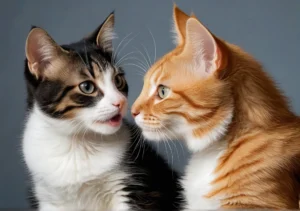Cats have a reputation for being aloof, mysterious creatures, but why are they so often perceived as angry? Let’s explore the reasons behind their seemingly grumpy demeanor.
Feline Behavior Myths Debunked
Let’s set the record straight when it comes to common misconceptions about our feline friends. Cats often get a bad rap for being angry or aloof, but the truth is, they are complex creatures with a wide range of emotions. One common myth is that cats are always angry, but this couldn’t be further from the truth. Cats may display behaviors that we interpret as anger, such as hissing or swatting, but these are often defensive reactions to perceived threats. Understanding the reasons behind these behaviors can help demystify your cat’s seemingly angry demeanor.
Understanding Body Language
Cats communicate largely through their body language, so learning to interpret their signals can give you valuable insight into their emotions. For instance, a cat with their ears flattened back and a twitching tail may be feeling agitated or upset. Conversely, a cat with relaxed ears and a gently swaying tail is likely feeling content and at ease. By paying attention to these subtle cues, you can better understand your cat’s mood and avoid misinterpreting their behavior as anger. Remember, cats have their own unique ways of expressing themselves, so taking the time to learn their language can strengthen your bond with your feline companion.
Additional Unique Insight: One often overlooked aspect of cat body language is their whiskers. When a cat’s whiskers are pulled back tightly against their face, it can indicate that they are feeling fearful or threatened. On the other hand, whiskers that are relaxed and slightly forward suggest a more calm and contented state. So, next time you’re trying to gauge your cat’s emotions, take a look at their whiskers for an extra clue into how they’re feeling.
The Importance of Environmental Enrichment
Is your cat constantly on edge, showing signs of anger or frustration? Providing an enriched environment can work wonders in improving their mood. Set up scratching posts, cat trees, puzzle feeders, and interactive toys to keep them mentally stimulated and physically active. Consider rotating their toys regularly to prevent boredom. Additionally, design cozy hiding spots and vertical spaces for them to explore and feel safe. A well-enriched environment can help reduce stress and prevent outbursts of anger in your feline friend.
Additional Unique Insight:
- Create a “cat TV” by placing bird feeders outside a window for your cat to watch. This can provide hours of entertainment and mental stimulation.
Socialization and Bonding
Building a strong bond with your cat from a young age is crucial in fostering trust and understanding. Spend quality time with your feline companion, engaging in play sessions and gentle petting. Encourage positive interactions by respecting their boundaries and preferences. By socializing your cat early on and establishing a bond based on mutual trust, you can help reduce their overall stress levels and promote a peaceful and harmonious relationship.
Remember, a happy cat is a well-socialized cat.
Health Issues and Behavioral Problems
Is your cat always angry? Understanding that this behavior could be a result of underlying health issues or behavioral problems is crucial. Cats may exhibit anger as a response to pain, discomfort, or stress. It’s important to consult with your veterinarian to rule out any medical conditions that could be causing your cat’s aggression. Behavioral issues such as fear, anxiety, or territorial behavior can also manifest as anger in cats. Addressing these problems can help improve your cat’s overall well-being.
Positive Reinforcement Training Techniques
When dealing with a perpetually angry cat, positive reinforcement training techniques can be incredibly effective. Rewarding good behavior with treats, toys, or affection can help encourage desirable behaviors and build a stronger bond with your feline friend. Avoid punishing or scolding your cat for their angry outbursts as this can worsen the behavior. Instead, focus on rewarding positive actions and providing a calm and supportive environment for your cat to thrive in.
Tips for Positive Reinforcement Training:
- Consistency: Be consistent in your rewards and reinforce good behavior every time.
- Patience: Training takes time, so be patient with your cat and yourself.
- Use Treats Wisely: Choose high-value treats to motivate your cat during training sessions.
- Create a Safe Space: Provide your cat with a safe and comfortable environment to help reduce stress and anxiety.
- Seek Professional Help: If your cat’s aggression persists, consider consulting with a professional animal behaviorist for personalized guidance.
Managing Stress and Anxiety
Is your feline friend always on edge, ready to pounce at the slightest provocation? Cats can often display anger when they are stressed or anxious, just like us humans. To help your furry companion relax and become a calmer, happier cat, try implementing these strategies:
Create a Safe Environment: Make sure your cat has a quiet, cozy space to retreat to when feeling overwhelmed. Provide hiding spots, vertical spaces, and plenty of toys to engage their natural hunting instincts.
Establish a Routine: Cats thrive on routine, so try to feed them, play with them, and clean their litter box at the same times every day. Predictability can help reduce anxiety and improve their mood.
Use Interactive Toys: Engage your cat’s mind and body with interactive toys that mimic hunting behavior. This can help them release pent-up energy and reduce stress levels.
Provide Comfort: Offer your cat plenty of love and affection to reassure them that they are safe. Gentle petting, soothing words, and creating a warm lap can go a long way in calming their nerves.
Consider Pheromone Therapy: Products like Feliway release synthetic pheromones that mimic a cat’s natural calming scent. These can help reduce anxiety and promote relaxation in your cat.
Remember, every cat is unique, so it may take some trial and error to find the right combination of strategies that work for your furry friend. Be patient and consistent in your efforts to help them manage their stress and anxiety for a happier, less angry cat.
Seeking Professional Help
If despite your best efforts, your cat’s anger issues persist and start to interfere with their quality of life, it may be time to seek professional help from a veterinarian or animal behaviorist. These experts can offer valuable insights and support to address your cat’s emotional well-being. Here’s why it’s crucial:
Medical Evaluation: A veterinarian can rule out any underlying medical conditions that may be contributing to your cat’s behavior. Pain or discomfort could be causing them to lash out, and a thorough exam can help identify and treat these issues.
Behavioral Assessment: An animal behaviorist can observe your cat’s behavior, identify triggers for their anger, and recommend specific techniques to modify their responses. They can provide tailored strategies to address your cat’s unique needs.
Medication Management: In severe cases of anxiety or aggression, medication prescribed by a vet may be necessary to help your cat cope. This can be a valuable tool in conjunction with behavioral therapy to improve their emotional well-being.
Don’t hesitate to reach out for professional help if your cat’s anger persists despite your best efforts. Your furry friend deserves to live a happy, stress-free life, and with the right support, you can help them achieve that.
Fun Facts About Cat Behavior
Did you know that cats are not always angry? Despite their reputation for being moody creatures, cats actually have a wide range of emotions just like humans. They can feel happy, playful, curious, and even content. Understanding these emotions can help you better connect with your feline friend and create a harmonious environment at home.
Here are some interesting facts about cat behavior that might surprise you:
Purring isn’t always a sign of happiness : While we often associate purring with contentment, cats can also purr when they are feeling unwell or scared. It’s their way of self-soothing in times of stress.
Tail position matters : A cat’s tail position can tell you a lot about how they are feeling. A relaxed and upright tail indicates a happy and confident cat, while a puffed-up and twitching tail can signal agitation or fear.
Kneading is instinctual : When your cat kneads you with their paws, it’s not just a sign of affection – it’s a behavior they learn as kittens to stimulate their mother’s milk flow. So, it’s like a comforting memory for them.
Catnip isn’t for everyone : Not all cats are affected by catnip. It’s actually a hereditary trait, with about 50-70% of cats having a response to the herb. So, if your cat doesn’t seem interested in catnip, don’t worry – they’re perfectly normal.
Understanding these quirky behaviors can help you navigate your cat’s moods and build a stronger bond with your furry friend. So, next time your cat seems angry, remember that there may be more going on beneath the surface than meets the eye.
Alex, a passionate animal lover, has experience in training and understanding animal behavior. As a proud pet parent to two dogs and three cats, he founded AnimalReport.net to share insights from animal experts and expand his knowledge of the animal kingdom.




